1.BeautifulSoup4 介绍
BeautifulSoup4 是爬虫里面需要掌握的一个必备库,通过这个库,将使我们通过 requests 请求的页面解析变得简单无比,再也不用通过绞尽脑汁的去想如何正则该如何匹配内容了。(一入正则深似海虽然它使用起来效率很高效哈)
这篇文档介绍了 BeautifulSoup4 中基础操作,并且有小例子.让我来向你展示它适合做什么,如何工作,怎样使用,如何达到你想要的效果
1.1 BeautifulSoup4 是什么
Beautifulsoup4 是 Beautiful Soup 项目的第四个版本,也是当前的最新版本。
Beautiful Soup 是一个可以从 HTML 或 XML 文件中提取数据的 Python 库.它能够通过你喜欢的转换器实现惯用的文档导航,查找,修改文档的方式.Beautiful Soup 会帮你节省数小时甚至数天的工作时间.
Beautiful Soup 对 Python 2 的支持已于 2020 年 12 月 31 日停止:从现在开始,新的 Beautiful Soup 开发将专门针对 Python 3。Beautiful Soup 4 支持 Python 2 的最终版本是 4.9.3。
HTML 文档本身是结构化的文本,有一定的规则,通过它的结构可以简化信息提取。于是,就有了 lxml、pyquery、BeautifulSoup 等网页信息提取库。一般我们会用这些库来提取网页信息。其中,lxml 有很高的解析效率,支持 xPath 语法(一种可以在 HTML 中查找信息的规则语法);pyquery 得名于 jQuery(知名的前端 js 库),可以用类似 jQuery 的语法解析网页。但我们今天要说的,是剩下的这个:BeautifulSoup。
BeautifulSoup(下文简称 bs)翻译成中文就是“美丽的汤”,这个奇特的名字来源于《爱丽丝梦游仙境》(这也是为何在其官网会配上奇怪的插图,以及用《爱丽丝》的片段作为测试文本)。
1.2 使用之前对:数据结构中--‘树’的理解 回顾
简单回顾一下数据结构中关于树的基本知识,脑海中有个树的样子哈
结点的概念
结点:上面的示意图中每一个数据元素都被称为"结点"。
结点的度:结点所拥有的子树的个数称为该结点的度。 上图中 A 节点的子树的数量就是三个,它的度就是 3。
根结点:每一个非空树都有且只有一个被称为根的结点。 上图中里面的 A 就是当前树的根节点。
子结点、父结点、兄弟结点:树中一个结点的子树的根结点称为这个结点的子结点,这个结点称为孩子结点的父结点。具有同一个父结点的子结点互称为兄弟结点。 上图中 B、C、D 就是兄弟节点,同时也是 A 的孩子节点,C 是 G 双亲节点
叶子结点:度为 0 的结点称为叶子结点,或者称为终端结点。 上图中的 K、M 就是叶子节点的代表
<!DOCTYPE html><html> <head> <meta charset="UTF-8"> <link rel="stylesheet" type="text/css" href="style.css"> <script type="application/javascript" src="script.js"></script> <title>I’m the title</title> </head> <body> <h1>HelloWorld</h1> <div> <div> <p>picture:</p> <img src="example.png"/> </div> <div> <p>A paragraph of explanatory text...</p> </div> </div> </body></html>
复制代码
上面的 HTML 源码通过 HTML 文档解析构建 DOM 树就会形成如下的效果
2.安装 BeautifulSoup4 模块库
# 安装BeautifulSoup4pip install BeautifulSoup4
复制代码
基本使用流程:通过文本初始化 bs 对象->通过 find/find_all 或其他方法检测信息->输出或保存
官方文档很友好,也有中文,推荐阅读 :
官方中文版说明 https://www.crummy.com/software/BeautifulSoup/bs4/doc.zh/
下表列出了主要的解析器,以及它们的优缺点:
2.1 案例基础操作
下面的一段 HTML 代码将作为例子练习
html_doc = """<html><head><title>The Dormouse's story</title></head><body><p class="title"><b>The Dormouse's story</b></p>
<p class="story">Once upon a time there were three little sisters; and their names were <a href="http://example.com/elsie" class="sister" id="link1">Elsie</a>, <a href="http://example.com/lacie" class="sister" id="link2">Lacie</a> and <a href="http://example.com/tillie" class="sister" id="link3">Tillie</a>; and they lived at the bottom of a well.</p>
<p class="story">...</p>"""
复制代码
分析
2.2 完整代码练习
# 导包from bs4 import BeautifulSoup
html_doc = """<html><head><title>The Dormouse's story</title></head><body><p class="title"><b>The Dormouse's story</b></p>
<p class="story">Once upon a time there were three little sisters; and their names were<a href="http://example.com/elsie" class="sister" id="link1">Elsie</a>,<a href="http://example.com/lacie" class="sister" id="link2">Lacie</a> and<a href="http://example.com/tillie" class="sister" id="link3">Tillie</a>;and they lived at the bottom of a well.</p>
<p class="story">...</p>"""# 创建对象html_doc((使用BeautifulSoup解析这段代码,能够得到一个 BeautifulSoup 的对象,并能按照标准的缩进格式的结构输出:))soup = BeautifulSoup(html_doc, 'html.parser')
# 按照html标准的缩进格式的结构输出:print(soup.prettify())
# 1 获取title标签的所有内容print("1.获取title标签的所有内容:", soup.title)
# 2 获取title标签的名称print("2.获取title标签的名称:", soup.title.name)
# 3 获取title标签的文本内容print("3.获取title标签的文本内容:", soup.title.string)
# 4 获取head标签的所有内容print("4.获取head标签的所有内容:", soup.head)
# 5 获取第一个p标签中的所有内容print("5.获取第一个p标签中的所有内容:", soup.p)
# 6 获取第一个p标签的class的值print("6.获取第一个p标签的class的值:", soup.p["class"])
# 7 获取第一个a标签中的所有内容print("7.获取第一个a标签中的所有内容:", soup.a)
# 8 获取所有的a标签中的所有内容print("8.获取所有的a标签中的所有内容", soup.find_all("a"))
# 9 获取id="link2"print("9.获取id=link2", soup.find(id="link2"))## 10 获取所有的a标签,并遍历打印a标签中的href的值for item in soup.find_all("a"): print(item.get("href"))
# 11 获取所有的a标签,并遍历打印a标签的文本值for item in soup.find_all("a"): print(item.get_text())
复制代码
输出结果:"D:\Program Files1\Python\python.exe" D:/Pycharm-work/pythonTest/打卡/0818-BeautifulSoup4.py<html> <head> <title> The Dormouse's story </title> </head> <body> <p class="title"> <b> The Dormouse's story </b> </p> <p class="story"> Once upon a time there were three little sisters; and their names were <a class="sister" href="http://example.com/elsie" id="link1"> Elsie </a> , <a class="sister" href="http://example.com/lacie" id="link2"> Lacie </a> and <a class="sister" href="http://example.com/tillie" id="link3"> Tillie </a> ;and they lived at the bottom of a well. </p> <p class="story"> ... </p> </body></html>1.获取title标签的所有内容: <title>The Dormouse's story</title>2.获取title标签的名称: title3.获取title标签的文本内容: The Dormouse's story4.获取head标签的所有内容: <head><title>The Dormouse's story</title></head>5.获取第一个p标签中的所有内容: <p class="title"><b>The Dormouse's story</b></p>6.获取第一个p标签的class的值: ['title']7.获取第一个a标签中的所有内容: <a class="sister" href="http://example.com/elsie" id="link1">Elsie</a>8.获取所有的a标签中的所有内容 [<a class="sister" href="http://example.com/elsie" id="link1">Elsie</a>, <a class="sister" href="http://example.com/lacie" id="link2">Lacie</a>, <a class="sister" href="http://example.com/tillie" id="link3">Tillie</a>]9.获取id=link2 <a class="sister" href="http://example.com/lacie" id="link2">Lacie</a>http://example.com/elsiehttp://example.com/laciehttp://example.com/tillieElsieLacieTillie
Process finished with exit code 0
复制代码
以上就是 BeautifulSoup 的一个极简上手介绍,对于 bs 能做什么,想必你已有了一个初步认识。如果你要在开发中使用,建议再看下它的官方文档。文档写得很清楚,也有中文版,你只要看了最初的一小部分,就可以在代码中派上用场了
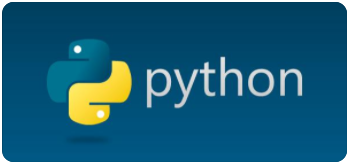

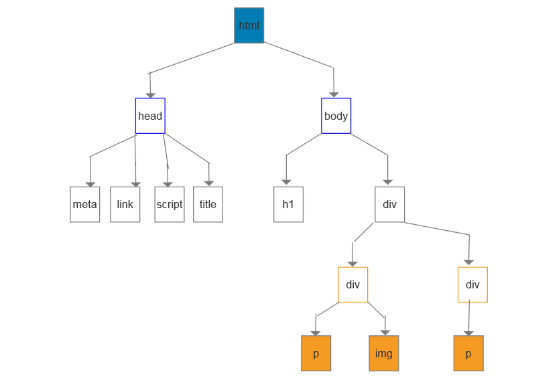
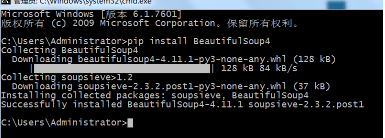
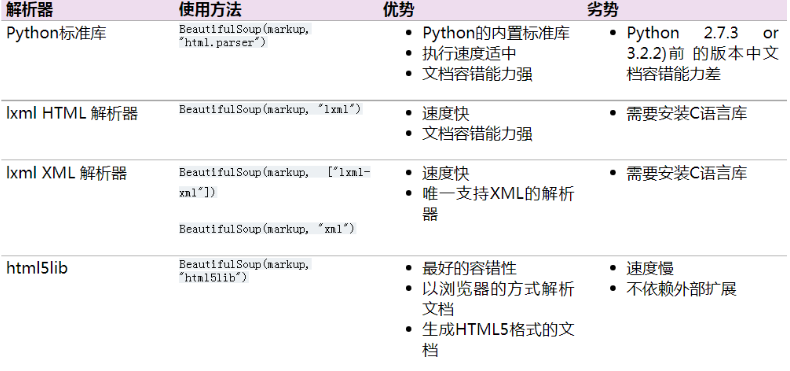
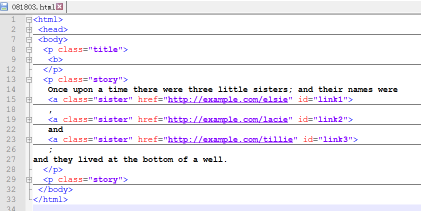











评论